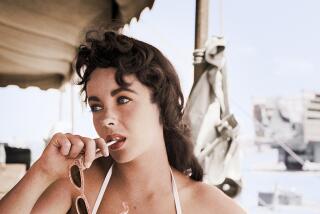Planning Wedding of the Century: Art and Internet
- Share via
When Christine Engels Taylor graduated from college 16 years ago, it was the dawn of the personal computer age.
She was ready.
Taylor was one of only a few female students at the University of Illinois at Urbana-Champaign who had earned degrees in the relatively new discipline of computer science engineering.
“I was thrilled. The possibilities of the personal computer to change people’s lives seemed incredible,” said Taylor, a 39-year-old computer industry veteran who owns a Costa Mesa computer graphics company and teaches part time at Orange Coast College. “I thought: Everyone is going to be able to have access to one of these machines. They’re going to be in everyone’s home, even if it takes 20 years to happen.”
Taylor once again sees herself on the threshold of a new age, the age of the Internet. And like the personal computer, the Internet is destined to become an integral part of everyday life, she believes.
“It’s just a matter of time until the economics make it affordable for the average person to access the Internet at its highest level of performance. But a lot of people have decided that even if they can only do e-mail, they want to be on the Internet,” she said.
But equally important to the future of the Internet is content, said Taylor, a Costa Mesa resident who worked for several computer companies as a programmer and products manager before returning to college to earn a fine arts degree. Although the Internet has actually been around a long time, she sees the content improving as it incorporates more of the creative arts.
“The whole thing that created this phenomenon of the Internet is that pictures came into the situation. I was on the Internet when I got hired at Texas Instruments in 1980. It’s been in existence since the early 1960s, but no one much cared about it. Unless you were in the sciences, you wouldn’t even have a computer in the first place to get on it. You had to have a mainframe.
“It was basically lines of text, and you had to know special characters and special commands to work with it. When they changed it more into a language like what we speak, when they changed it so pictures and colors could come into the format, then people got interested.”
Taylor teaches what she preaches. At Orange Coast College, she guides her students through 3-D animation and other fine arts classes linked to computer technology. And she believes her career will continue to evolve along with the technology.
She is working on a specialized master’s degree in art education from the Art Institute of Chicago. The degree program combines the disciplines of education, art and technology, which Taylor says are the fundamental components needed to make the Internet more interesting to the average user.
“There is a lot of junk on the Internet. It’s still too technologically oriented. It draws in a lot of people who have the technical expertise to know how to put a web page up. But then, what do they put in it? What do they have to say once they do it?”
Taylor says Internet service providers are increasingly seeking the services of educators, writers and artists of all kinds, a trend she predicts will create a kind of technological Renaissance of the arts.
“It’s going to take the technical and it’s going to take the artistic; there’s going to be a marriage between those skills. Why would [Microsoft founder] Bill Gates join up with Steven Spielberg? That’s the trend: Entertainment marries the computer.”
And Taylor says it is only a matter of time until computers and televisions merge into one all-purpose unit connected to the information superhighway.
“All you need to do is add some extra circuitry, get the television industry to hook into the Internet in some way, and voila! Your television becomes a computer. It’s not that far away. When the first home computers came out, the television was the monitor.
“For the first time, we have the ability to put every artistic medium into the computer. Video, photography, paintings, newspapers--for the first time we have one venue for the synthesis of all these different kinds of art. This is increasingly infiltrating people’s personal lives. We still need to do a lot more thinking about what this could mean.”
What it means for Taylor, in part, is to keep the addictive nature of technology in check. During her off-hours, she paints, rides a bicycle and works on bodybuilding.
“When I go home, I’m tired of computers by the end of the day. And I don’t particularly like games on the computer.
“I’m probably on the computer almost 16 hours a day and I just won’t think about getting back on it after work.”
(BEGIN TEXT OF INFOBOX / INFOGRAPHIC)
Profile: Christine Engels Taylor
Age: 39
Hometown: Moline, Ill.
Residence: Costa Mesa
Family: Single
Education: Bachelor’s degree in computer science engineering, University of Illinois at Urbana-Champaign; bachelor’s degree in studio art, UCI; working toward master’s degree in art education, Art Institute of Chicago
Past: Computer programmer for Pentagon and NASA while earning first university degree; joined Texas Instruments in Irvine in 1980 as computer programmer and organized customer support program; became product manager for Wyle Laboratories, a Garden Grove computer products distributor, in 1985
Present: Part-time computer and fine arts teacher, Orange Coast College since 1989; owns Artful Concepts, an eight-year-old Costa Mesa computer graphics business; multimedia producer for JobLink in Costa Mesa, designing instructional computer-based curriculum for adult literacy classes
On the Internet generation: “Can you believe what it’s going to be like 20 years from now when people sit around and say, ‘Oh yeah, I remember when my dad and I created a Web site.’ That just blows me away.”
Source: Christine Engels Taylor; Researched by RUSS LOAR / For The Times






